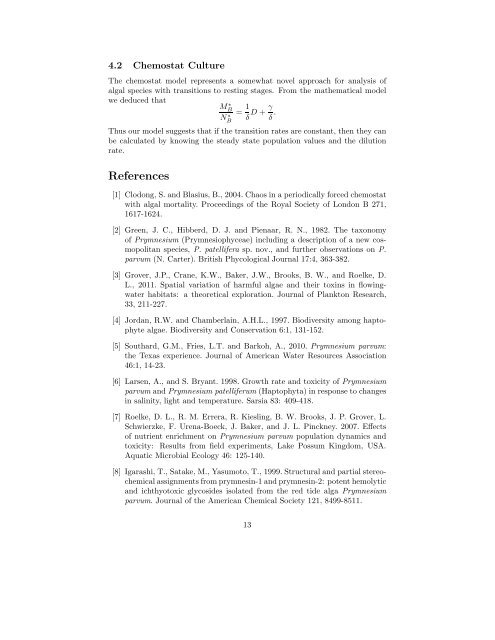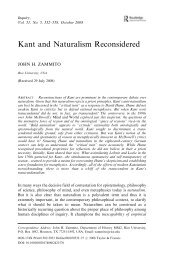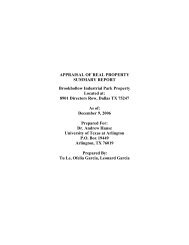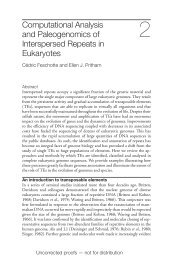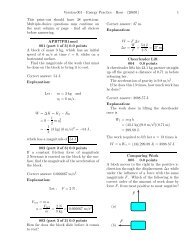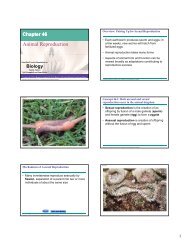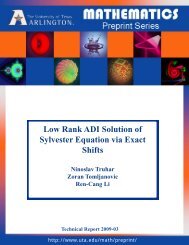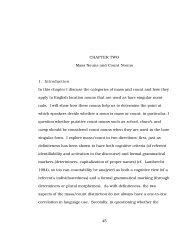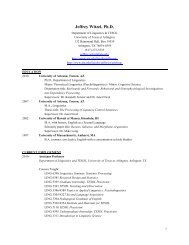Resting Stages and the Population Dynamics of Harmful Algae in ...
Resting Stages and the Population Dynamics of Harmful Algae in ...
Resting Stages and the Population Dynamics of Harmful Algae in ...
- No tags were found...
Create successful ePaper yourself
Turn your PDF publications into a flip-book with our unique Google optimized e-Paper software.
4.2 Chemostat CultureThe chemostat model represents a somewhat novel approach for analysis <strong>of</strong>algal species with transitions to rest<strong>in</strong>g stages. From <strong>the</strong> ma<strong>the</strong>matical modelwe deduced thatMB∗NB∗ = 1 δ D + γ δ .Thus our model suggests that if <strong>the</strong> transition rates are constant, <strong>the</strong>n <strong>the</strong>y canbe calculated by know<strong>in</strong>g <strong>the</strong> steady state population values <strong>and</strong> <strong>the</strong> dilutionrate.References[1] Clodong, S. <strong>and</strong> Blasius, B., 2004.Chaos <strong>in</strong> a periodically forced chemostatwith algal mortality. Proceed<strong>in</strong>gs <strong>of</strong> <strong>the</strong> Royal Society <strong>of</strong> London B 271,1617-1624.[2] Green, J. C., Hibberd, D. J. <strong>and</strong> Pienaar, R. N., 1982. The taxonomy<strong>of</strong> Prymnesium (Prymnesiophyceae) <strong>in</strong>clud<strong>in</strong>g a description <strong>of</strong> a new cosmopolitanspecies, P. patellifera sp. nov., <strong>and</strong> fur<strong>the</strong>r observations on P.parvum (N. Carter). British Phycological Journal 17:4, 363-382.[3] Grover, J.P., Crane, K.W., Baker, J.W., Brooks, B. W., <strong>and</strong> Roelke, D.L., 2011. Spatial variation <strong>of</strong> harmful algae <strong>and</strong> <strong>the</strong>ir tox<strong>in</strong>s <strong>in</strong> flow<strong>in</strong>gwaterhabitats: a <strong>the</strong>oretical exploration. Journal <strong>of</strong> Plankton Research,33, 211-227.[4] Jordan, R.W. <strong>and</strong> Chamberla<strong>in</strong>, A.H.L., 1997. Biodiversity among haptophytealgae. Biodiversity <strong>and</strong> Conservation 6:1, 131-152.[5] Southard, G.M., Fries, L.T. <strong>and</strong> Barkoh, A., 2010. Prymnesium parvum:<strong>the</strong> Texas experience. Journal <strong>of</strong> American Water Resources Association46:1, 14-23.[6] Larsen, A., <strong>and</strong> S. Bryant. 1998. Growth rate <strong>and</strong> toxicity <strong>of</strong> Prymnesiumparvum <strong>and</strong> Prymnesium patelliferum (Haptophyta) <strong>in</strong> response to changes<strong>in</strong> sal<strong>in</strong>ity, light <strong>and</strong> temperature. Sarsia 83: 409-418.[7] Roelke, D. L., R. M. Errera, R. Kiesl<strong>in</strong>g, B. W. Brooks, J. P. Grover, L.Schwierzke, F. Urena-Boeck, J. Baker, <strong>and</strong> J. L. P<strong>in</strong>ckney. 2007. Effects<strong>of</strong> nutrient enrichment on Prymnesium parvum population dynamics <strong>and</strong>toxicity: Results from field experiments, Lake Possum K<strong>in</strong>gdom, USA.Aquatic Microbial Ecology 46: 125-140.[8] Igarashi, T., Satake, M., Yasumoto, T., 1999.Structural <strong>and</strong> partial stereochemicalassignmentsfromprymnes<strong>in</strong>-1<strong>and</strong>prymnes<strong>in</strong>-2:poten<strong>the</strong>molytic<strong>and</strong> ichthyotoxic glycosides isolated from <strong>the</strong> red tide alga Prymnesiumparvum. Journal <strong>of</strong> <strong>the</strong> American Chemical Society 121, 8499-8511.13


